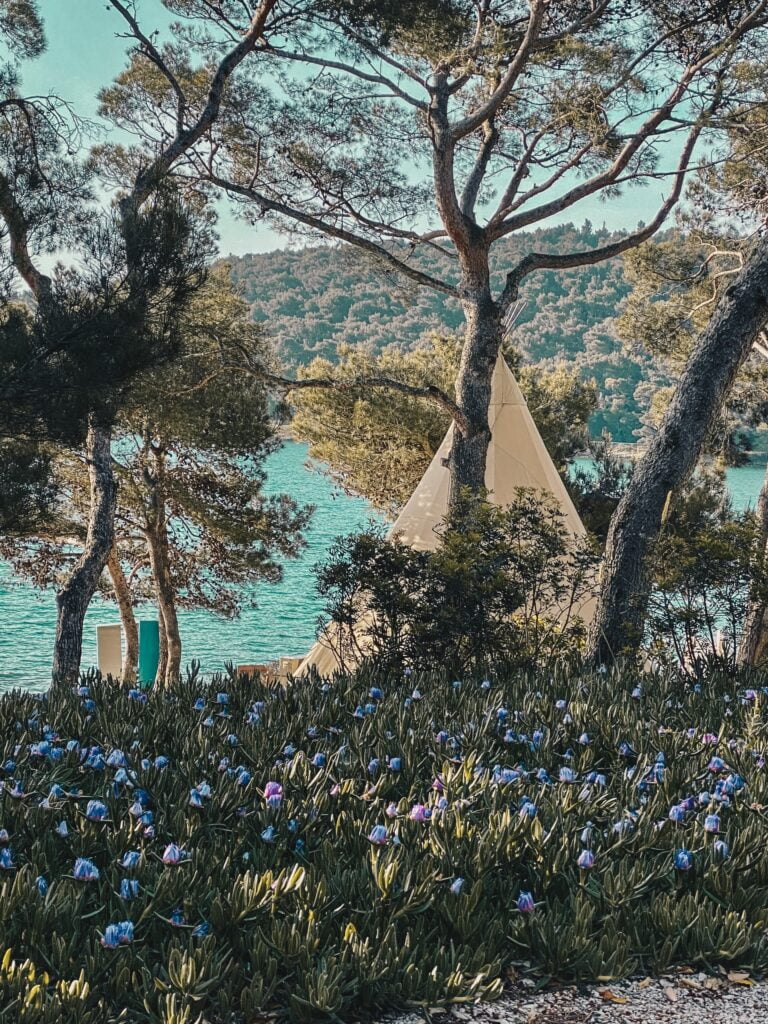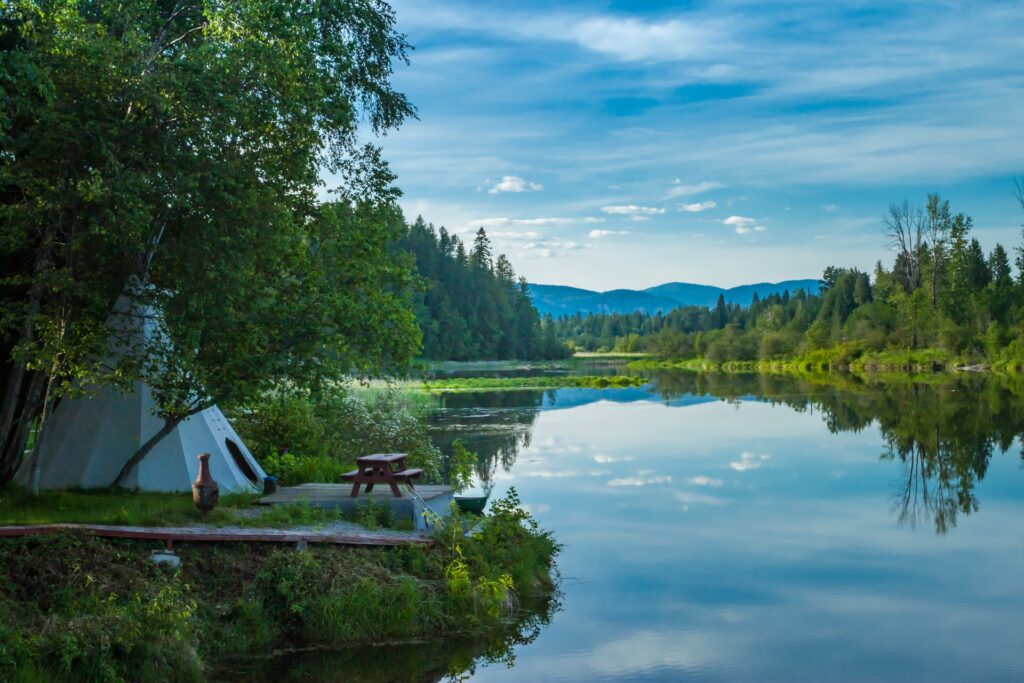Glamping is an exciting new industry that offers great potential for profit if done correctly!
Imagine owning your own piece of land where you can build your very own luxury camping resort. You have the freedom to design it however you like, from choosing what type of tents or cabins are used to deciding on how many amenities will be included.
When choosing how much land you need for glamping, a good rule of thumb is to provide at least 1 acre per tent for a mountain-style site, or at least 0.25 acres per tent for a beach-style site, so that all guests can enjoy enough space for privacy.
However, there are some considerations you need to keep in mind before you purchase a piece of property.
Hopefully this article will help answer some of the questions you may have. There isn’t really a “magic number,” so we’ll take a look at some different variables and decide together what would work best for your needs.
Table of Contents
Can I Put Glamping Tents On My Land?
One of the most important considerations when starting a glamping business is whether or not you can even operate the way you want in the first place.
Technically speaking, sure. You can install a glamping tent on your land provided you are using it for personal use and you meet all the safety regulations and laws of your local jurisdiction.
But as soon as you decide you want to run a glamping business then things get a bit more complicated. For instance, we reached out to our local planning office and inquired as to what it would take to set up a glampsite and this is what we were told:
“Camping in Island County outside of legally established campgrounds is illegal. This includes staying overnight in tents, RV’s, “Tiny Homes”, yurts, wall tents, etc. There is a way to legally establish a campground via the Site Plan Review process, but feasibility and approval depend on the zoning and site characteristics of the parcel in question. Anything that is slept in overnight outside of a legally established campground is going to need to meet all applicable building, health department, and public works requirements. There are a lot of “glamping” camp sites appearing these days, advertising on various websites, and the vast majority of them are operating illegally.”
If you thought you could just buy a piece of property and put a glampsite on Airbnb then this is disappointing news, but it can be done. You just have to get the proper planning permissions first.
Which will differ from county to county and state to state.
How Much Land Do You Need For Glamping?
While there is no “magic number” or hard and fast rule, a good rule of thumb is to not cram as many glamping tents onto a property as you possibly can, as that makes it feel like a rental farm and not a glamping site.
A beach-style experience is different than a mountain/forest-style experience, or a desert-experience.
In general, you will want to build one glamping tent per 1 acre of property to provide enough space for a good mountain/forest style experience. If you are near a beach, or in view of a beach, you can set your tents in an array facing the view and space them more closely (one tent per 0.25 acre, for example).
If you are just starting out, it’s better to start small and then grow or expand as your business evolves. You will be in control of how much land the tents take up rather than feeling like there is no room for new guests because the facilities are already over capacity.
The best way to determine how large your land should be is to plan out the type of experience you are looking to provide, and build your tent around that.
Since the glamping experience is about being around nature or out in the country, it’s not a good idea to place one in your backyard next to the house.
What Should Be Considered Before Buying Land

Not all land is created equal, and even if you think you found the perfect property there might be some hidden surprises.
Aside from the legalities of running glamping business, you should consider what kind of nature the property is surrounded by, what kind of facilities you want to provide, insurance, etc.
You’ll want to account for the size of your glamping tents, RV’s or other accommodations. How many people will be staying at your site? Are you looking to have more than one tent on your land? If so, how much space is needed between each structure?
This can vary from a few feet all the way up to several hundred feet.
You’ll want to account for how much space you’ll need for the glampsite itself, as well as any other amenities that may be available onsite such as a common area with a kitchen and bathroom facilities or an RV hookup.
The size of your site will depend on what type of accommodations are allowed in the area.
Here are some things you should be aware of:
Consider The Location Of Your Land
Whether your glamping business is going to be a success will largely depend on where you choose to set up, both legally and practically.
A glamping site in the middle of the city will likely not be a good location, but neither would something out in the middle of the forest that is difficult to get to.
If it’s your intention to offer accommodations that are specifically for individuals, then be sure you find a location with plenty of green space and access near hiking trails or other outdoor attractions.
On the other hand, if your glamping business will cater more closely to families or groups of people, then a more rural location will be better.
Land Features (wooded, open, lakes/streams, beaches, road access)
In essence, your glamping site should be built around the type of experience you are able to provide.
For instance, if you are interested in creating an environment for local residents or families who wouldn’t mind being away from their everyday lives and living in the woods (either as part of a therapeutic process or simply because they want a different experience), then find land with lakes, streams, and other natural features that can be enjoyed.
But sometimes you might not be able to get a piece of land with those features. In those cases, simply being around activities that people want to do (like being near a beach or having access to a hiking trail) can be enough.
In all cases, your land should be easily accessible via a road.
Check Zoning Laws And Permits For Campgrounds
As mentioned above, the legalities of operating a glamping business are the same as those of a campground. Be sure to check with your county or township zoning office for any stipulations about what you can and cannot do before buying land on which to erect tents, cabins, etc.
Also be aware that glamping operators are held to more stringent safety standards than camper trailer parks because guests may stay for longer periods of time.
In addition, the zoning classification of your property will be crucial in determining how you can use it as a glampsite and whether or not there are any limitations on the number of guests that may visit at one time, or even the types of amenities you can provide.
How Will You Maintain The Land?
It’s easy to think of all the money you’re going to be making on Airbnb with a glamping site and forget about the maintenance and upkeep of the land and facilities.
In order for your property to maintain its “glamped-out” aesthetic, it is important that it be maintained just like a regular home would be – with lawn care (even if it’s fake grass), water drainage systems, restrooms, cleaning, etc.
If you want to be successful, you’ll have to run your camping site like a business and plan out your maintenance accordingly, in addition to your usual cleaning of the units between guests.
What Is The Best Way To Utilize Natural Resources?
Of course, no one wants to have to completely overhaul their land before they get started. So one consideration you should make is how well you can utilize the nature that is already there and incorporate it into your designs.
Many people find it more practical to use the trees and other natural features on their property, rather than trying to bring in plants from elsewhere. Trees can be used for shade, privacy screening or protection from wind/snow. And with a little creativity you might find that some of your existing flora is also helpful.
Plan Where Your Buildings Will Go
Much like the above tip, it’s not a bad idea to plan out exactly where you would like your buildings and other structures to go before purchasing any land as well.
One suggestion is buying property that has an existing structure already on it, such as barns or homes, which can provide shelter for some of the camping infrastructure without additional investment.
When it comes time to purchase land, you can figure out how to best use the space and plan accordingly.
Planning is a huge step that’s often overlooked when it comes to glamping sites but is one of the most important steps in ensuring success.
You may even want to create these plans and submit it to your local land use office for approval before purchasing the land, just in case.
Determine What Utilities You Need
When we asked our local planning office about setting up a glamping site, their answer alluded to needing to be in compliance with applicable building requirements, among other things.
So it’s very likely that the land you purchase will need utilities hooked up such as power and water.
In some locations, providing solar power for charging devices and powering lights is enough to meet regulations and many glamping sites out in the desert do this.
Water is another luxury that you cannot afford to be without.
Underground water tanks can be buried on the glamping site or dug into a hillside, and they are easy to connect to your plumbing system once installed, however this would drive up maintenance costs and it may be more desirable to drill a well.
Final Thoughts
There are a lot of factors that go into purchasing land for glamping, so it’s important to think about the location of your land and what features you might want before making any decisions.
We hope you found these tips helpful. Remember, the more detailed your plan is before setting up camp, the smoother things will go when it comes time to host your glamping site on Airbnb!
You’ve made a great decision to get into the glamping industry, but before you buy land, consider what will make your business successful.
If you have any other questions about how to set up a glamping site or starting a glamping business, check out our blog for more information!




